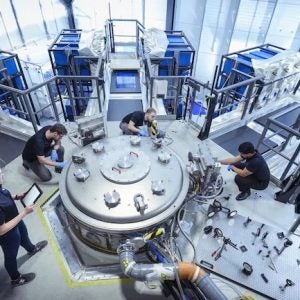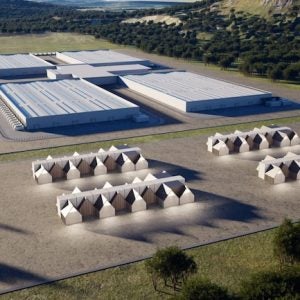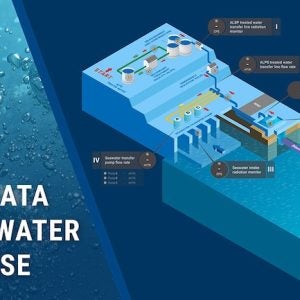
US fusion start-up Commonwealth Fusion Systems (CFS) has begun assembling the SPARC tokamak, which is intended to demonstrate net fusion energy by generating more power from fusion than is needed to start and maintain the process. “That’s a crucial step toward our later ARC power plants that actually put power on the grid starting in the early 2030s at a site in Chesterfield County, Virginia,” the company said.
In March, CFS, which was spun out from the Massachusetts Institute of Technology (MIT) in 2018, installed the SPARC tokamak’s first element, the disc-shaped stainless steel cryostat base. “We rolled it in on tracks, lowered it into place with a crane, levelled it, and fixed it in place with bolts and grout. It’s now nestled into its home in Devens, Massachusetts, surrounded by systems to power and cool it.” CFS noted.
“With the cryostat base now in place, we’ve begun building the heart of our fusion energy system,” said Samer Hamade, CFS Vice President of Projects. “This is a very visible example of how the CFS fusion energy project has shifted into a new phase, tokamak assembly. It’s really energising to see the first part of SPARC filling what was a circular hole in the floor – a true testament to the hard work and dedication of the team.”
CFS has been developing SPARC step by step for years. It began with research on the best way to take the monumental step of demonstrating net fusion energy. “We fostered a supply of the high-temperature superconductors (HTS) key to SPARC’s compact design. We began manufacturing SPARC’s magnets based on large-scale prototypes. We built SPARC’s building,” CFS said. Less than four years ago, what’s now the SPARC facility was just a dirt lot.
To keep SPARC’s superconducting magnets cold enough to perform well, CFS houses them inside a larger chamber called cryostat that insulates them from the outside world with a vacuum. The cryostat base is the bottom of this structure. Besides maintaining the vacuum to help keep the tokamak interior cold, it:
- Supports SPARC’s 1,000-tonne weight;
- Absorbs some of the neutrons the fusion process creates;
- Accommodates conduits for helium coolant, magnet power, and communication links to internal sensors.
The cryostat base is 24 feet in diameter and weighs 75 tonnes. It is a carefully designed and manufactured component, a piece of steel made to exacting specifications then shipped with a protective blue metal cap. A police escort shepherded the cryostat base along its preplanned route to Devens.
In coming months, CFS will also drop D-shaped toroidal field (TF) magnets into two orange stands, insert SPARC’s vacuum vessel into the interior of those TF magnets, add the circular poloidal field (PF) magnets that loop around the structure, drop the cylindrical central solenoid (CS) magnets down the centre of the tokamak, and seal the whole assembly with the cryostat sides and top.
CFS has already installed ancillary equipment around SPARC. This includes the systems to power and cool the tokamak’s super-strong magnets, the diagnostic sensors to monitor the fusion process, and the heating system to turn SPARC’s hydrogen fuel into a plasma for the fusion process.
“We completely designed the base simultaneously with all SPARC system interfaces like magnet supports, power, cryogenics, vacuum pumping, and instrumentation. And we received it on time after speedy fabrication,” said Moji Safabakhsh, a Director of Engineering at CFS. “Installation of the cryostat base is a watershed moment starting the assembly process and interconnecting SPARC to the balance of the plant.”
The US Department of Energy’s Innovation Network for Fusion Energy (INFUSE) programme awarded CFS three new grants in August 2023 to fund research & development projects with the University of California at Berkeley, Princeton Plasma Physics Lab, and University of California at Los Angeles. The INFUSE award programme is intended to accelerate fusion energy development through public-private research partnerships.
CFS has received a total of 21 INFUSE awards, and has past or present collaborative projects with12 US National Labs and universities. SPARC is being developed in collaboration with MIT’s Plasma Science & Fusion Centre, which is also designing the compact ARC (affordable, robust, compact) fusion reactor.






